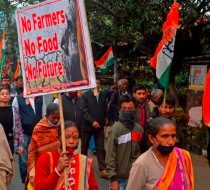India's Farmer Protests Favorite
Since November 2020, tens of thousands of farmers have been living in tents at sprawling camps pitched on highways outside the capital New Delhi.
Large barricades erected by the police and topped with barbed wire stand a few hundred meters from the camp, preventing the farmers from encroaching any closer to the center of Delhi. At times, violence has broken out during demonstrations.
The farmers are fighting new farming laws passed last September, which they say will devastate their livelihoods. The government says the reforms are needed to modernize the country's agricultural industry.
With negotiations between the government and the farmers' unions at a standstill, the protests don't appear to be ending anytime soon. Here's what you need to know about the situation.
For decades, the Indian government has offered guaranteed prices to farmers for certain crops, creating a stable guide to make decisions and investments for the following crop cycle.
Under the previous laws, farmers had to sell their goods at auction at their state's Agricultural Produce Market Committee, where they were guaranteed to receive at least the government-agreed minimum price. There were restrictions on who could buy, and prices were capped for essential commodities.
Three new laws, initiated by the government of Prime Minister Narendra Modi, dismantled this committee structure, instead allowing farmers to sell their goods to anyone for any price.
Modi says this gives farmers more freedom to do things such as sell directly to buyers without a middle man, and sell to other states or large grocery chains.
But many farmers argue the laws will allow big companies to drive down prices. While farmers could sell crops at higher prices if the demand is there, conversely, they could struggle to meet the minimum price in years when there is too much supply.
The mass protests began soon after the laws passed in September.
In November, infuriated farmers drove in tractor conveys from around India to set up multiple blockades at New Delhi's borders. Thousands marched from other nearby states to the city, where violence soon erupted, with police firing tear gas and water cannons to stop them from entering the capital.
The protests continued throughout December, with supporters across the country participating in labor and hunger strikes. At times, demonstrations swelled to more than 100,000 people on Delhi's outskirts -- though largely peaceful, there were occasional flare-ups of violence and scuffles with police.
The government has faced criticism for how it has handled the protests, particularly the violent clashes between farmers, their supporters and Delhi police during a tractor parade on Republic Day in January.







